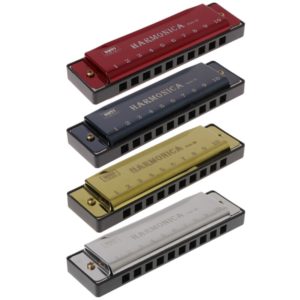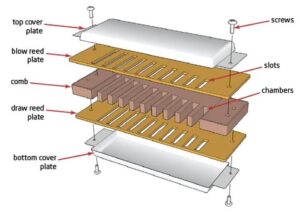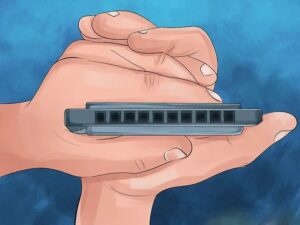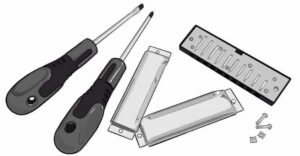10 Hole Diatonic Blues Harmonica:
A Beginner’s Guide to Playing the Blues
 If you’re a music enthusiast with a passion for the blues, then the 10-hole diatonic blues harmonica is the perfect instrument for you. This small and portable instrument is used to create the soulful sounds of the blues and is a favourite among blues musicians all over the world.
If you’re a music enthusiast with a passion for the blues, then the 10-hole diatonic blues harmonica is the perfect instrument for you. This small and portable instrument is used to create the soulful sounds of the blues and is a favourite among blues musicians all over the world.
Playing the blues harmonica might seem intimidating at first, but with the right guidance and practice, it can be an incredibly rewarding experience. In this beginner’s guide, we’ll explore the basics of playing the 10-hole diatonic blues harmonica, including how to choose the right harmonica, how to hold and play the instrument, and some simple techniques to get you started. So, grab your harmonica and let’s get started on your journey to becoming a blues harmonica player!
Anatomy of the Diatonic Blues Harmonica
 Before we dive into playing the harmonica, it’s important to understand its anatomy. The 10-hole diatonic blues harmonica consists of a plastic or metal comb with 10 holes, reed plates, and covers. The reed plates are thin metal plates with reeds attached to them, which vibrate when air is blown or drawn through them. The covers are used to protect the reed plates and can be removed for cleaning or maintenance.
Before we dive into playing the harmonica, it’s important to understand its anatomy. The 10-hole diatonic blues harmonica consists of a plastic or metal comb with 10 holes, reed plates, and covers. The reed plates are thin metal plates with reeds attached to them, which vibrate when air is blown or drawn through them. The covers are used to protect the reed plates and can be removed for cleaning or maintenance.
It’s essential to choose a quality harmonica for the best playing experience. There are many brands to choose from, including Hohner, Suzuki, and Lee Oskar.
Beginner harmonicas are often less expensive and may not produce the same quality sound as more professional options. However, as a beginner, it’s important to choose a harmonica that is easy to play and maintain.
Understanding the Musical Scale
 The 10-hole diatonic blues harmonica is a versatile instrument capable of playing a range of musical scales and modes. The most common scale used in blues music is the pentatonic scale. This scale consists of five notes and is used to create the classic blues sound.
The 10-hole diatonic blues harmonica is a versatile instrument capable of playing a range of musical scales and modes. The most common scale used in blues music is the pentatonic scale. This scale consists of five notes and is used to create the classic blues sound.
To play the blues scale on the harmonica, you must understand the layout of the notes. The holes on the harmonica are numbered from one to ten, with lower numbers on the left side and higher numbers on the right. The notes on the harmonica are played by blowing or drawing air through the holes. When you blow air through a hole, the note played is determined by the number of the hole. For example, blowing air through hole one produces the note “C.” Drawing air through a hole produces a different set of notes. To play the blues scale, you’ll need to learn how to bend notes, which we’ll discuss in the next section.
How to Hold and Play the Harmonica
 To play the harmonica, hold it between your lips and blow air through the holes. The top cover of the harmonica should be facing outward, away from your lips. It’s essential to hold the harmonica correctly to produce clear and concise notes.
To play the harmonica, hold it between your lips and blow air through the holes. The top cover of the harmonica should be facing outward, away from your lips. It’s essential to hold the harmonica correctly to produce clear and concise notes.
When playing, you can use either the tongue blocking or puckering technique. Tongue-blocking involves placing your tongue on specific holes to produce different notes. Puckering involves pursing your lips to create a smaller opening for the air to pass through, producing a higher-pitched sound.
To play a single note, position your mouth over the desired hole and blow or draw air through the hole. To play multiple notes, move your mouth across the harmonica, covering and uncovering the desired holes.
Basic Harmonica Techniques: Bending, Tongue Blocking, and Vibrato
Bending is a technique used to alter the pitch of a note by changing the shape of your mouth. This technique is used to create the bluesy sound commonly heard in blues music. To bend a note, draw air through the harmonica and lower your jaw slightly while shaping your mouth in an “O” position. This will cause the pitch of the note to drop.
Tongue blocking is a technique used to isolate specific holes on the harmonica to produce different notes. To use this technique, place your tongue on the holes you want to block, allowing air to pass through the uncovered holes.
Vibrato is a technique used to add character and expression to your playing. To achieve vibrato, move your jaw slightly up and down while playing a note. This will create a slight variation in pitch, adding a unique sound to your playing.
Learning the Blues Scale and Playing Simple Blues Melodies
Now that you understand the basics of playing the harmonica, it’s time to learn the blues scale and some simple melodies. The blues scale consists of five notes: the root note, flat third, fourth, flat fifth, and flat seventh.
To play the blues scale, start with the root note and play each note in succession. For example, in the key of C, the blues scale would be C, E-flat, F, G-flat, and B-flat. Practice playing the scale in different keys to improve your technique.
To play simple blues melodies, start by playing the root note followed by the other notes in the blues scale. Experiment with different rhythms and phrasings to create your unique sound. It’s okay to start with simple melodies and work your way up to more complex pieces.
Advanced Techniques: Overblowing and Tongue Slapping
Once you’ve mastered the basics of playing the harmonica, you can experiment with more advanced techniques like overblowing and tongue slapping.
Overblowing involves producing a note higher than the natural range of the harmonica by blowing harder and changing the shape of your mouth. This technique requires a lot of practice and patience to master.
Tongue slapping is a percussive technique used to create a popping sound by slapping your tongue against the reed plates while playing. This technique adds a unique sound to your playing and can be used to create rhythm and texture in your playing.
Playing with Backing Tracks and Jamming with Others
Playing with backing tracks is an excellent way to improve your playing and develop your ear for music. There are many backing tracks available online that you can use to practice playing different styles of music.
Jamming with others is also an excellent way to improve your playing skills. You can join a local blues jam session or find other musicians to play with online. Playing with others allows you to develop your skills and learn from other musicians.
Maintenance and Care of Your Harmonica
 It’s essential to maintain and care for your harmonica properly to ensure it lasts for a long time. After each playing session, remove the cover plates and gently clean the reed plates with a soft cloth. Do not use water or cleaning solutions, as this can damage the reeds.
It’s essential to maintain and care for your harmonica properly to ensure it lasts for a long time. After each playing session, remove the cover plates and gently clean the reed plates with a soft cloth. Do not use water or cleaning solutions, as this can damage the reeds.
Store your harmonica in a clean, dry place when not in use. Avoid exposing your harmonica to extreme temperatures, as this can cause the reeds to warp or bend.
Resources and Further Learning Opportunities
There are many resources available online to help you learn to play the harmonica. YouTube is an excellent source of video tutorials, and there are many online courses and instructional books available.
Attending harmonica workshops and music festivals is also an excellent way to improve your playing skills and connect with other musicians.
Conclusion
![]() Playing the 10-hole diatonic blues harmonica is a rewarding experience that requires patience, practice, and dedication. Following the tips outlined in this beginner’s guide, you’ll be on your way to becoming a skilled harmonica player in no time. Remember to choose a quality harmonica, learn the blues scale, and practice regularly to develop your skills. With time and practice, you’ll be playing soulful blues melodies that will impress your friends and family.
Playing the 10-hole diatonic blues harmonica is a rewarding experience that requires patience, practice, and dedication. Following the tips outlined in this beginner’s guide, you’ll be on your way to becoming a skilled harmonica player in no time. Remember to choose a quality harmonica, learn the blues scale, and practice regularly to develop your skills. With time and practice, you’ll be playing soulful blues melodies that will impress your friends and family.
